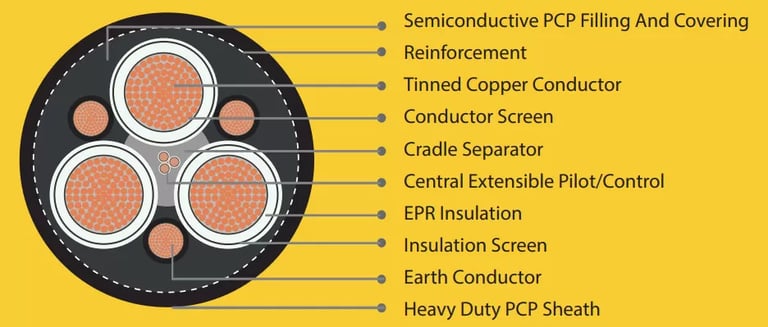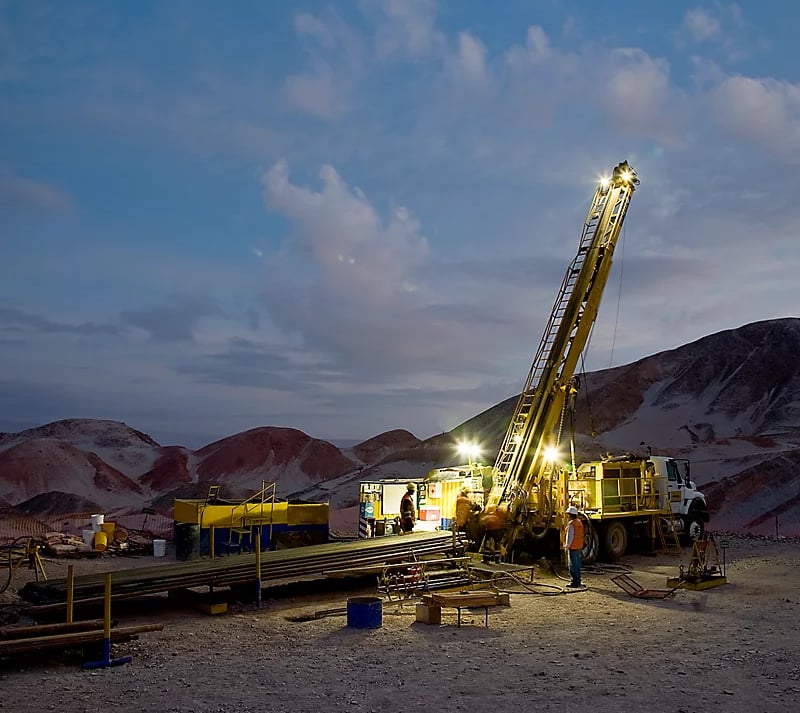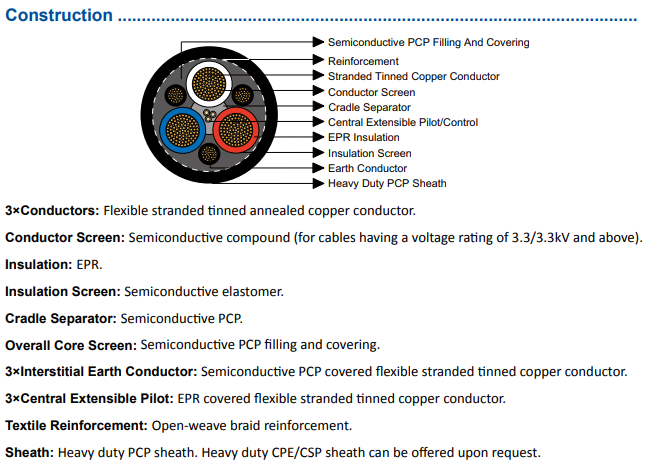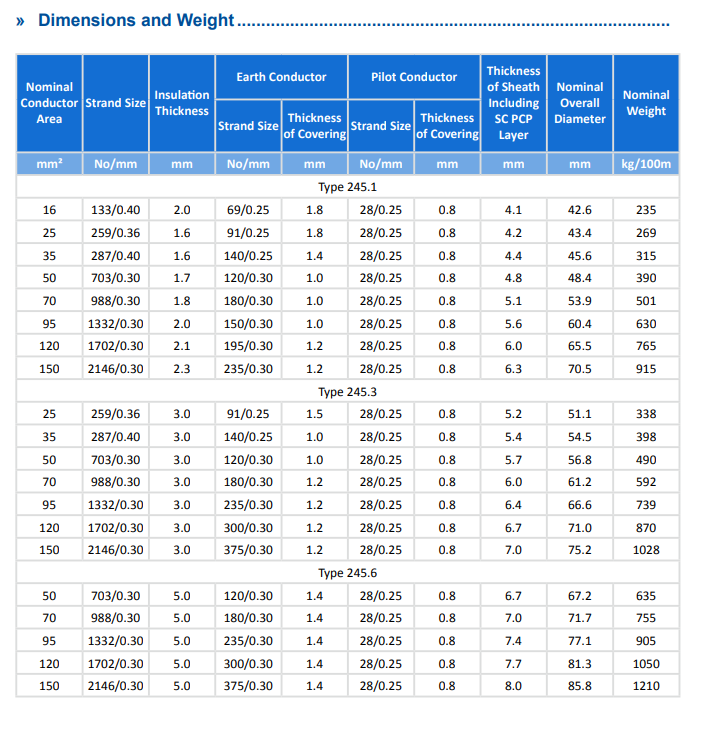Anhui Feichun Special Cable Co.,Ltd Li.wang@feichuncables.com
Mastering AS/NZS Type 245 Flexible Rubber Longwall Shearer Mining Cable: A Comprehensive Guide
Explore the design, function, and safety features of AS/NZS Type 245 mining cables. Learn why this robust and flexible rubber-sheathed cable is vital for longwall shearers in Australian underground coal mines.
Li.wang@Feichun Cable
7/23/20255 min read


In the harsh and dynamic environment of Australian underground coal mining, the reliability of power transmission systems is paramount. Among the various types of mining cables developed to meet such demanding requirements, the AS/NZS Type 245 Flexible Rubber Longwall Shearer Mining Cable stands out. Engineered for high flexibility, mechanical resilience, and thermal endurance, Type 245 cables are the lifelines for longwall shearers and related equipment.
This in-depth article explores the structure, standards, specifications, and operational value of Type 245 mining cables, focusing on their pivotal role in ensuring continuous, safe, and efficient energy delivery in Australia's underground mining sector.
Cable Function and Primary Applications
The Type 245 cable is purpose-built for mobile and heavy-duty applications, particularly in underground coal mining operations.
Powering Longwall Shearers
The primary function of the Type 245 cable is to power longwall shearers, which are massive cutting machines that remove coal from the face of the seam. These machines are in near-constant motion, requiring cables that are not only durable but also highly flexible to accommodate frequent bending and flexing.
Supporting Continuous Miners
In addition to shearers, Type 245 cables are widely used with continuous miners, which require rugged, trailing cables to handle continuous repositioning and harsh operational stresses underground.
Peripheral Equipment Support
Peripheral systems such as roof bolters, conveyors, and hydraulic units in longwall operations often rely on the same cable type, thanks to its multi-core structure, pilot conductors, and reinforced jacket design.
Reeling and Trailing Environments
Due to its excellent flex-life, the Type 245 cable thrives in reeling and trailing applications, especially where rapid movement, torsion, and abrasion are prevalent.
Deployment in Australian Mines
Most commonly found in New South Wales (NSW) and Queensland (QLD), these cables are essential infrastructure in high-production underground mines that operate around the clock in challenging conditions.
Standards Compliance and Certification
Conformance to Australian/New Zealand standards is vital for ensuring cable performance, reliability, and regulatory acceptance in mining operations.
AS/NZS 1802:2003
Specifies the construction, performance, and testing of reeling and trailing cables for mining and general industrial applications. It ensures resistance to mechanical, electrical, and thermal stress.
AS/NZS 1125
Defines the physical and electrical properties of copper conductors, focusing on material purity, stranding configurations, and conductivity.
AS/NZS 3808
Outlines the testing methods and requirements for insulating and sheathing materials, ensuring the cable withstands abrasion, flame, and chemical exposure.
AS/NZS 5000.1
Specifies requirements for power cables with extruded insulation, including EPR and XLPE. This is essential for medium-voltage applications from 1.1 kV up to 6.6 kV.
These standards collectively guarantee the performance, safety, longevity, and acceptance of Type 245 cables across Australian mine sites.
Electrical and Mechanical Specifications
The AS/NZS Type 245 cable is engineered for robust electrical performance and mechanical durability.
Voltage Ratings
Typically rated for 1.1/1.1 kV, 3.3/3.3 kV, or 6.6/6.6 kV, allowing adaptability for various equipment voltage demands.
Temperature Range
Operational temperature ranges from -25°C to +90°C, enabling year-round functionality in both hot tunnels and cooler ambient shafts.
High Flexibility
Utilises high strand-count tinned copper conductors, offering superior flexibility and minimizing conductor fatigue from repetitive bending.
Resistance Features
Abrasion Resistance: Outer sheaths are formulated to withstand rough handling and contact with rocks.
Water and Oil Resistance: Prevents degradation due to environmental exposure.
Flame Resistance: Essential for reducing fire risk in confined spaces.
Mechanical Stress Resistance: Reinforced layers absorb tension and compression.
Core and Pilot Configuration
Typical arrangement includes 3 power cores + 3 pilot cores + earth conductors, providing both power and communication/control capabilities in a single cable.
Construction Materials and Design Highlights
The internal construction of the Type 245 cable is a combination of advanced materials designed to meet mining demands.
Conductors
Flexible tinned copper, stranded for high flexibility and reduced corrosion risk.
Insulation
EPR (Ethylene Propylene Rubber) insulation is chosen for its excellent thermal resistance, dielectric properties, and elasticity.
Screens
Semiconductive screens surround both conductors and insulation, improving electrical field control and reducing the chance of breakdown.
Sheathing
Outer sheath options include:
PCP (Polychloroprene) for rugged applications.
CSP (Chlorosulfonated Polyethylene) or CPE on request for enhanced chemical resistance.
Reinforcements
Open-weave textile braiding strengthens the cable against torsion and tension during reeling or dragging.
This structural sophistication allows Type 245 cables to endure high dynamic stress, extend service life, and maintain integrity in rugged underground settings.
Environmental and Operational Advantages
AS/NZS Type 245 cables are particularly valued for their adaptability to extreme mining conditions.
Dynamic Motion Tolerance
Capable of handling:
Frequent coiling and uncoiling
Reeling and unreeling from cable drums
Dragging along uneven mine floors
Tight Radius Flexibility
With highly elastic insulation and fine-stranded cores, the cable can operate in tight conduit layouts and confined longwall setups without cracking or fatigue.
Environmental Resistance
Performs reliably in:
High humidity
Dust-laden air
High temperature tunnels
Long-Term Reliability
The design supports prolonged use under flexing and tension cycles, with minimal degradation, reducing the need for frequent replacements.
Maintenance and Inspection Considerations
Proper maintenance is crucial to ensure safety and prolong the life of Type 245 cables.
Periodic Inspection Checklist:
Sheath Integrity: Look for cuts, abrasions, or swellings.
Insulation Resistance: Test regularly using megohmmeter.
Pilot Circuit Continuity: Ensure the monitoring/control loops are functional.
Best Practices:
Storage: Use cable drums; avoid sharp bends or direct UV exposure.
Transport: Minimise dragging across abrasive surfaces.
Handling: During reeling/unreeling, maintain correct bend radii and avoid torsion.
Adhering to inspection and handling best practices ensures compliance with mine safety protocols and maximizes asset lifespan.
Industry Use Cases in Australia
Numerous underground coal mines in New South Wales and Queensland have adopted Type 245 cables as part of their core infrastructure.
Case Study: High-Production Seam in NSW
In a longwall operation producing over 8 million tonnes annually, Type 245 cables have shown:
Exceptional insulation integrity
Minimal mechanical degradation
Low downtime due to cable failure
Regulatory Compliance Audits
Routine compliance checks by mine safety regulators have confirmed the cables’ adherence to:
Flame retardancy tests
Insulation resistance standards
Earth continuity loop checks
Safety Records
Mines using AS/NZS Type 245 cables have reported fewer cable-related accidents, thanks to their robust construction and fault-monitoring capabilities.
Frequently Asked Questions (FAQ)
Q1: Can Type 245 cables be used in open-pit mines?
A: While designed primarily for underground environments, they may be adapted for surface use with proper protection and fittings.
Q2: How often should Type 245 cables be inspected?
A: Typically every 3–6 months or after 500 operational hours, whichever comes first.
Q3: What makes EPR insulation better than XLPE for mining?
A: EPR provides superior flexibility and thermal resistance, essential for dynamic and hot underground settings.
Q4: Can I repair a damaged Type 245 cable on-site?
A: Minor sheath damage may be patched, but significant damage near conductors or pilots should be replaced or spliced per AS/NZS guidelines.
Q5: Are these cables flame-retardant?
A: Yes. The sheath material meets AS/NZS flame resistance criteria, reducing fire propagation risk.
The AS/NZS Type 245 Flexible Rubber Longwall Shearer Mining Cable is more than a power conduit—it is a safety-critical component in Australia's underground mining operations. Its sophisticated design, rigorous standards compliance, and proven reliability make it a preferred choice in high-mobility, high-demand environments like longwall operations.
By investing in Type 245 cables, mining operations not only ensure efficient power delivery but also elevate safety standards, reduce maintenance costs, and improve overall operational uptime.
As Australia continues to push for smarter and more sustainable mining technologies, cables like Type 245 will likely evolve with advanced materials, IoT-based monitoring, and enhanced fault-detection capabilities, marking the next chapter in underground cable engineering.









Email Address: Li.wang@feichuncables.com
© 2025. All rights reserved.


One-click to Quickly Contact
Products
Offshore & Marine Cable
XLPE Cable
Contact
Company
Location:
Building A Private Science and Technology Park, Hefei Economic and Technological Development Zone, Anhui Province, China
